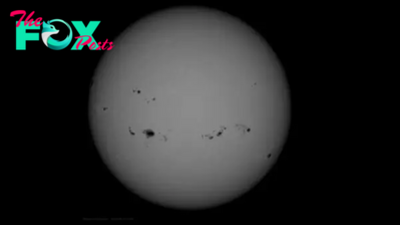Science
Earth from space: Picturesque plankton paint peculiar patterns in Patagonia
Where is it? The Patagonian Shelf Break, off Argentina.
What's in the photo? A massive phytoplankton bloom.
Which satellite took the photo? Suomi National Polar-orbiting Partnership (Suomi NPP).
When was it taken? Dec. 2, 2014.
This striking satellite photo captures a gigantic phytoplankton bloom painting the sea with a colorful collection of swirls and striations.
The brilliant bloom, which appeared between November 2014 and March 2015 off the east coast of Chubut province, Argentina, occurred in a patch of the South Atlantic Ocean known as the Patagonian Shelf Break. When this photo was taken, the rippling mass of algae stretched more than 1,000 miles (1,600 kilometers) across.
The Patagonian Shelf Break is one of the world's most prolific phytoplankton hotspots. During the Southern Hemisphere's spring and summer, a combination of windblown dust from the mainland, iron-rich ocean currents and the upwelling of cold waters from the deep sea provide the perfect mix of nutrients and conditions for phytoplankton to grow and reproduce, according to NASA's Earth Observatory.
The swirling shapes are caused by spiraling ocean currents known as eddies, and the thicker bands of algae are likely the result of horizontal mixing where patches of warm and cold water collide, according to Earth Observatory.
Related: See all the best images of Earth from space

The photo shows two main types of phytoplankton. Coccolithophores, a group of algae that surround themselves with armor plating made from calcium carbonate, make up the lighter aquamarine swirls, while the darker green patches are a mix of diatoms, dinoflagellates and other species that are rich with the photosynthetic pigment chlorophyll, according to Earth Observatory. (Specific wavelengths of light were enhanced in this photo to differentiate between these types.)
The blooming algae provide enough food to support an abundance of marine life and help to remove large amounts of carbon dioxide from the atmosphere via photosynthesis. However, these ecological benefits are now under threat from a hidden side effect of human-caused climate change — ocean acidification.
-

 Science22h ago
Science22h agoCatastrophic collision between Milky Way and Andromeda galaxies may not happen after all, new study hints
-

 Science1d ago
Science1d agoElon Musk said he's 'definitely going to be dead' before humans go to Mars — and you probably will be too
-

 Science1d ago
Science1d agoMars May Have Far More Water Than We Thought
-

 Science2d ago
Science2d agoSpace photo of the week: James Webb telescope catches baby stars roaring to life
-

 Science3d ago
Science3d agoDo opposites really attract in relationships?
-

 Science3d ago
Science3d agoNew ISS images showcase auroras, moon and space station in glorious photos
-

 Science3d ago
Science3d agoHow will the trapped Boeing Starliner astronauts perceive time after 6 months in space?
-

 Science3d ago
Science3d agoAuroras headed to the US again in aftermath of gargantuan 'X-class' solar flare





















